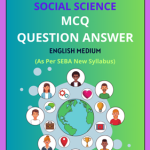SEBA Class 6 Social Science MCQ Chapter 6 Major landforms of the earth Solutions in English Medium, Class 6 Social Science Multiple Choice Question Answer to each chapter is provided in the list so that you can easily browse throughout different chapters SEBA Class 6 Social Science MCQ Chapter 6 Major landforms of the earth Question Answer and select need one.
SEBA Class 6 Social Science MCQ Chapter 6 Major landforms of the earth
Also, you can read the SCERT book online in these sections SEBA Class 6 Social Science Objective Type Solutions by Expert Teachers as per SCERT (CBSE) Book guidelines. These solutions are part of SCERT All Subject Solutions. Here we have given Assam SEBA Class 6 Social Science MCQ Solutions for All Subject, You can practice these here.
Major landforms of the earth
Chapter – 6
| MCQ |
1. What are the three main types of landforms?
(a) Mountains, Plains, Deserts.
(b) Mountains, Plateaus, Plains.
(c) Plateaus, Plains, Valleys.
(d) Deserts, Valleys, Plateaus.
Answer: (b) Mountains, Plateaus, Plains.
2. Which of the following is an example of a young fold mountain?
(a) The Aravalli Range.
(b) The Himalayas.
(c) The Appalachian Mountains.
(d) The Ural Mountains.
Answer: (b) The Himalayas.
3. The Deccan Plateau is located in which country?
(a) India.
(b) China.
(c) Brazil.
(d) Australia.
Answer: (a) India.
4. Which of the following is a feature of plains?
(a) High elevation.
(b) Steep slopes.
(c) Gentle slopes.
(d) Volcanic activity.
Answer: (c) Gentle slopes.
5. What is the primary activity in the plains?
(a) Mining.
(b) Agriculture.
(c) Tourism.
(d) Fishing.
Answer: (b) Agriculture.
6. Which type of plateau is formed by volcanic activity?
(a) Tectonic plateau.
(b) Residual plateau.
(c) Volcanic plateau.
(d) Erosional plateau.
Answer: (c) Volcanic plateau.
7. The Tibetan Plateau is also known as the:
(a) Roof of the World.
(b) Land of the Rising Sun.
(c) Heart of Asia.
(d) Crown of the Continent.
Answer: (a) Roof of the World.
8. Which of the following is not a type of mountain?
(a) Fold Mountain.
(b) Block Mountain.
(c) Dome Mountain.
(d) Valley Mountain.
Answer: (d) Valley Mountain.
9. Which landform is characterised by flat-topped areas that are higher than the surrounding land?
(a) Plains.
(b) Mountains.
(c) Plateaus.
(d) Valleys.
Answer: (c) Plateaus.
10. What type of landform is created by the deposition of sediments by rivers?
(a) Mountains.
(b) Plateaus.
(c) Plains.
(d) Deserts.
Answer: (c) Plains.
11. Which mountain range is considered the oldest in the world?
(a) Himalayas.
(b) Andes.
(c) Aravallis.
(d) Rockies.
Answer: (c) Aravallis.
12. What type of plains are formed due to the upliftment of the land?
(a) Depositional plains.
(b) Structural plains.
(c) Erosional plains.
(d) Glacial plains.
Answer: (b) Structural plains.
13. Which plateau is known for its extensive volcanic activity?
(a) Colorado Plateau.
(b) Deccan Plateau.
(c) Tibetan Plateau.
(d) Canadian Shield.
Answer: (b) Deccan Plateau.
14. Which type of mountain is formed by the folding of the Earth’s crust?
(a) Volcanic mountains.
(b) Block mountains.
(c) Fold mountains.
(d) Residual mountains.
Answer: (c) Fold mountains.
15. The Andes mountain range is located on which continent?
(a) Asia.
(b) Europe.
(c) South America.
(d) North America.
Answer: (c) South America.

Hi! my Name is Parimal Roy. I have completed my Bachelor’s degree in Philosophy (B.A.) from Silapathar General College. Currently, I am working as an HR Manager at Dev Library. It is a website that provides study materials for students from Class 3 to 12, including SCERT and NCERT notes. It also offers resources for BA, B.Com, B.Sc, and Computer Science, along with postgraduate notes. Besides study materials, the website has novels, eBooks, health and finance articles, biographies, quotes, and more.




